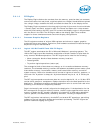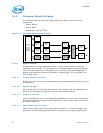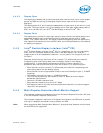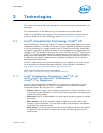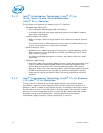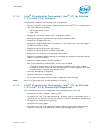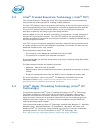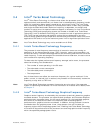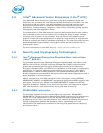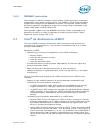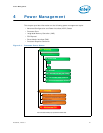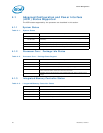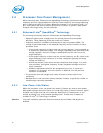
Datasheet, Volume 1 43
Technologies
3.4 Intel
®
Turbo Boost Technology
Intel
®
Turbo Boost Technology is a feature that allows the processor core to
opportunistically and automatically run faster than its rated operating frequency/render
clock if it is operating below power, temperature, and current limits. The Intel Turbo
Boost Technology feature is designed to increase performance of both multi-threaded
and single-threaded workloads. Maximum frequency is dependant on the SKU and
number of active cores. No special hardware support is necessary for Intel Turbo Boost
Technology. BIOS and the operating system can enable or disable Intel Turbo Boost
Technology. Intel Turbo Boost Technology will increase the ratio of application power to
TDP. Thus, thermal solutions and platform cooling that are designed to less than
thermal design guidance might experience thermal and performance issues since more
applications will tend to run at the maximum power limit for significant periods of time.
Note: Intel Turbo Boost Technology may not be available on all SKUs.
3.4.1 Intel
®
Turbo Boost Technology Frequency
The processor’s rated frequency assumes that all execution cores are running an
application at the thermal design power (TDP). However, under typical operation, not
all cores are active. Therefore most applications are consuming less than the TDP at the
rated frequency. To take advantage of the available thermal headroom, the active cores
can increase their operating frequency.
To determine the highest performance frequency amongst active cores, the processor
takes the following into consideration:
• The number of cores operating in the C0 state
• The estimated current consumption
• The estimated power consumption
•The temperature
Any of these factors can affect the maximum frequency for a given workload. If the
power, current, or thermal limit is reached, the processor will automatically reduce the
frequency to stay with its TDP limit.
Note: Intel Turbo Boost Technology processor frequencies are only active if the operating
system is requesting the P0 state. For more information on P-states and C-states, refer
to
Chapter 4.
3.4.2 Intel
®
Turbo Boost Technology Graphics Frequency
Graphics render frequency is selected by the processor dynamically based on graphics
workload demand. The processor can optimize both processor and Processor Graphics
performance by managing power for the overall package. For the integrated graphics,
this allows an increase in the render core frequency and increased graphics
performance for graphics intensive workloads. In addition, during processor intensive
workloads when the graphics power is low, the processor core can increase its
frequency higher within the package power limit. Enabling Intel Turbo Boost Technology
will maximize the performance of the processor core and the graphics render frequency
within the specified package power levels.



